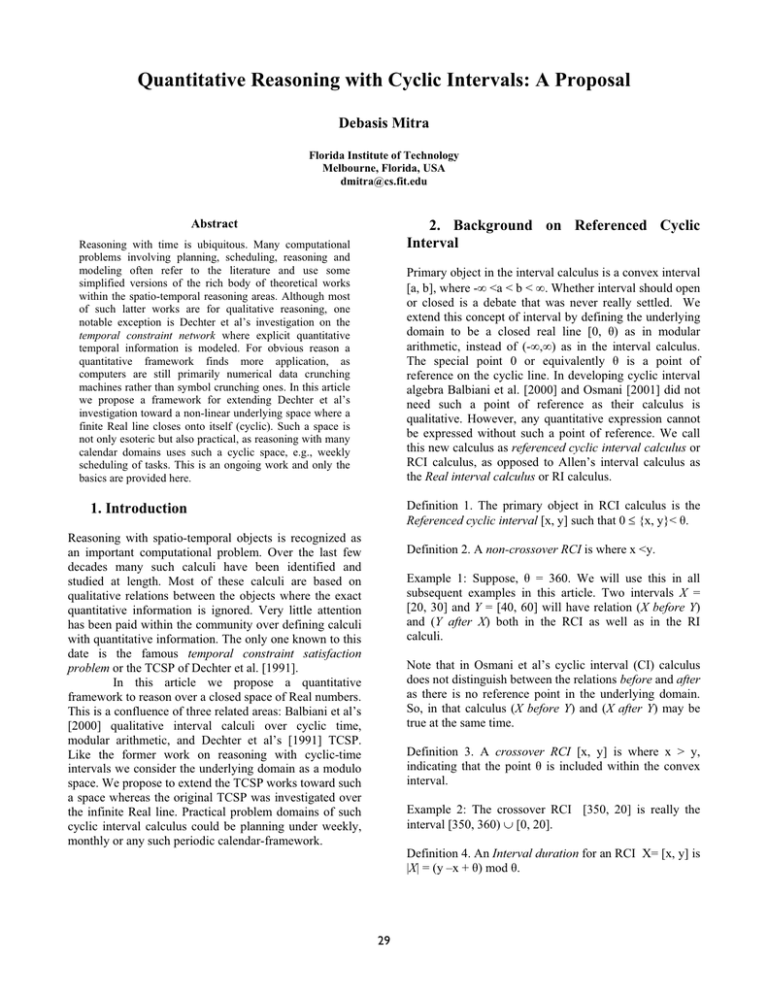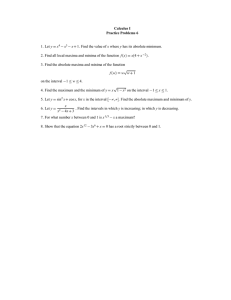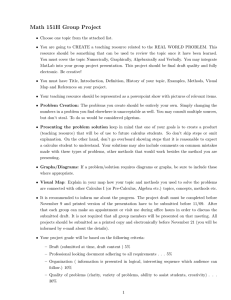Quantitative Reasoning with Cyclic Intervals: A Proposal Debasis Mitra Interval
advertisement

Quantitative Reasoning with Cyclic Intervals: A Proposal
Debasis Mitra
Florida Institute of Technology
Melbourne, Florida, USA
dmitra@cs.fit.edu
Abstract
2. Background on Referenced Cyclic
Interval
Reasoning with time is ubiquitous. Many computational
problems involving planning, scheduling, reasoning and
modeling often refer to the literature and use some
simplified versions of the rich body of theoretical works
within the spatio-temporal reasoning areas. Although most
of such latter works are for qualitative reasoning, one
notable exception is Dechter et al’s investigation on the
temporal constraint network where explicit quantitative
temporal information is modeled. For obvious reason a
quantitative framework finds more application, as
computers are still primarily numerical data crunching
machines rather than symbol crunching ones. In this article
we propose a framework for extending Dechter et al’s
investigation toward a non-linear underlying space where a
finite Real line closes onto itself (cyclic). Such a space is
not only esoteric but also practical, as reasoning with many
calendar domains uses such a cyclic space, e.g., weekly
scheduling of tasks. This is an ongoing work and only the
basics are provided here.
Primary object in the interval calculus is a convex interval
[a, b], where -f <a < b < f. Whether interval should open
or closed is a debate that was never really settled. We
extend this concept of interval by defining the underlying
domain to be a closed real line [0, ș) as in modular
arithmetic, instead of (-f,f) as in the interval calculus.
The special point 0 or equivalently ș is a point of
reference on the cyclic line. In developing cyclic interval
algebra Balbiani et al. [2000] and Osmani [2001] did not
need such a point of reference as their calculus is
qualitative. However, any quantitative expression cannot
be expressed without such a point of reference. We call
this new calculus as referenced cyclic interval calculus or
RCI calculus, as opposed to Allen’s interval calculus as
the Real interval calculus or RI calculus.
Definition 1. The primary object in RCI calculus is the
Referenced cyclic interval [x, y] such that 0 d {x, y}< ș.
1. Introduction
Reasoning with spatio-temporal objects is recognized as
an important computational problem. Over the last few
decades many such calculi have been identified and
studied at length. Most of these calculi are based on
qualitative relations between the objects where the exact
quantitative information is ignored. Very little attention
has been paid within the community over defining calculi
with quantitative information. The only one known to this
date is the famous temporal constraint satisfaction
problem or the TCSP of Dechter et al. [1991].
In this article we propose a quantitative
framework to reason over a closed space of Real numbers.
This is a confluence of three related areas: Balbiani et al’s
[2000] qualitative interval calculi over cyclic time,
modular arithmetic, and Dechter et al’s [1991] TCSP.
Like the former work on reasoning with cyclic-time
intervals we consider the underlying domain as a modulo
space. We propose to extend the TCSP works toward such
a space whereas the original TCSP was investigated over
the infinite Real line. Practical problem domains of such
cyclic interval calculus could be planning under weekly,
monthly or any such periodic calendar-framework.
Definition 2. A non-crossover RCI is where x <y.
Example 1: Suppose, ș = 360. We will use this in all
subsequent examples in this article. Two intervals X =
[20, 30] and Y = [40, 60] will have relation (X before Y)
and (Y after X) both in the RCI as well as in the RI
calculi.
Note that in Osmani et al’s cyclic interval (CI) calculus
does not distinguish between the relations before and after
as there is no reference point in the underlying domain.
So, in that calculus (X before Y) and (X after Y) may be
true at the same time.
Definition 3. A crossover RCI [x, y] is where x > y,
indicating that the point ș is included within the convex
interval.
Example 2: The crossover RCI [350, 20] is really the
interval [350, 360) [0, 20].
Definition 4. An Interval duration for an RCI X= [x, y] is
|X| = (y –x + ș) mod ș.
29
The RI calculus has 13 jointly exhaustive and pairwise
disjoint (JEPD) primitive relations between the RIs. CI
calculus similarly has 16 JEPDs.
reasoning scheme for simple TCSP where the constraint is
a RCPI instead of RI. In this article we will redefine the
fundamental operators behind such a reasoning scheme.
Some of this reasoning operators over RI is too intuitive
and never discussed in the literature whereas others are
addressed by Dechter et al. [1991] in their seminal work
on TCSP.
Proposition 1. RCI calculus has 52 primitive JEPD
primitive relations.
Proposition 3. The converse of a RCPI X = [x, y] is X =
[-y+ ș, -x+ ș]. Note that (A X B) Ù (B X A).
Proposition 1 can be easily verified by writing a small
program. These 52 relations subsumes the RI calculus’
thirteen primitive relations as well as CI calculus’ sixteen
primitive relations. However, as our purpose is to develop
a framework for quantitative reasoning scheme rather
than a qualitative one, we also allow points in the
calculus, or x=y in a RCI [x, y]. This scheme may be
called as referenced cyclic point-interval (RCPI) calculus.
Proposition 4. The inverse of a RCPI X = [x, y] is ~X =
[y, x].
The empty interval can be written as the inverse of the
universal interval [0, ș). Hence, ĭ is (ș, 0].
Performing set union and intersection over
convex intervals in modular arithmetic, or with the RCPIs
are not trivial. The main problem stems from representing
crossover RCPI and non-crossover RCPI uniformly for
the purpose of reasoning. For this purpose we develop
some ordering scheme for the end points of intervals in
the cyclic domain.
First, we will address the problem of finding the
position of a point p with respect to an interval X =[x1,
x2]. An algorithm Order(p, X) will output the following.
For x1 < x2 (i.e., non-crossover interval),
if p<x1, then the ordering is (p, x1, x2);
if p>x2, then the ordering is (x1, x2, p);
else the ordering is (x1, p, x2).
The first two cases above are when p is outside the
interval.
For x1 > x2 (i.e., crossover interval),
if p>x1, then the ordering is (x1, p, x2);
if p<x2, then the ordering is (x1, p, x2);
else the ordering is either (x1, x2, p) or (p, x1, x2), i.e., p
is outside the interval and the two orderings are
indistinguishable.
Now we are ready to position the end points of a
pair of intervals on the cyclic domain relative to each
other. Suppose, the two intervals are X =[x1, x2] and Y
=[y1, y2]. None, either, or both of them could be
crossover interval(s). We need to create a total ordering of
the four end points in order to define the union and
intersection operators between the pair of intervals. An
algorithm Order(X, Y) will use the previous algorithm
four times:
Order(x1, Y), Order(x2, Y), Order(y1, X), Order(y2, X).
The four relative three-point orderings can be
subsequently merged to the final four-point orderings as a
constraint satisfaction problem. The Union and the
Intersection operations can be done from the resulting
four-point orderings as follows.
Example 3. |[350, 20]| = (20 – 350 + 360) mod 360 = 30,
but |[20, 350]| = (350 – 20 + 360) mod 360 = 330.
Proposition 2. RCPI calculus has 75 JEPD primitive
relations (shown in the Appendix 1).
As in the case of RCI calculus proposition 2 may be also
be easily verified by exhaustive computation. Obviously,
RCPI primitive relations subsumes those for RCI.
We define two special RCPIs for the sake of
completion of the framework.
Definition 5. Universal Interval. is the unique
universal interval over the whole underlying domain [0,
ș), with the interval duration ș.
Definition 6. Empty Interval. ĭ is the unique empty
interval without any point in it and with the interval
duration 0.
3. TCSP with RCPI
In this section we extend Dechter et al’s [1991] temporal
constraint satisfaction problem with simple intervals over
the underlying cyclic domain. In TCSP a binary constraint
between two temporal events (points) is described as a set
of convex intervals.
Example 4. Tom takes twenty to thirty minutes to come to
office by car, but fifty to seventy minutes by public bus.
Formally this constraint is expressed in TCSP as (D {[20,
30], [50, 70]} A), where at time instant D Tom departs
from home and at A he arrives at his office.
A TCSP consists of a set of such binary
constraints over multiple temporal events.
Reasoning with only one convex interval over
each constraint, called simple TCSP, is tractable and has
been studied extensively. We propose to develop a
Definition 7. Union.
(1) For the ordering (x1, x2, y1, y2) or (y1, y2, x1, x2),
X Y = {X, Y}, because the intervals are disjoint.
30
(2) For the ordering (x1, y1, y2, x2),
X Y = X, and for the ordering (y1, x1, x2, y2),
X Y = Y, because one interval subsumes the other.
(3) For the ordering (x1, y1, x2, y2),
X Y = [x1, y2]. Symmetrically, for the ordering (y1,
x1, y2, x2),
X Y = [y1, x2].
(4) A special case when the four-point ordering cannot be
created is when the three-point orderings are {(x1, y2,
x2), (x1, y1, x2), (y1, x2, y2), (y1, x1, y2)}.
Here, X Y = , the universal interval. foundation for doing quantitative reasoning over cyclic
domains (with RCPI).
4. Related works and discussion
In this work we have developed an outline for reasoning
with quantitative constraints over a cyclic domain that we
call cyclic-TCSP in the line of Dechter et al’s [1991]
TCSP works over linear time or the domain of Real
numbers. TCSP is tractable with simple constraints
(convex intervals). The framework presented here is also
over similar convex constraints as opposed to the case of
multi-interval constraints (e.g., example 4) between
temporal events A and B. A valid question: is a simple
cyclic-TCSP as presented here also tractable? We do not
have any answer for that yet. However, observing the case
of qualitative reasoning with cyclic-intervals our guess
that this is not so in cyclic-TCSP. Reasoning with CI
calculus is intractable even with only primitive relations
as constraints (without any disjunction) [Balbiani et al.,
2000]. For most other spatio-temporal algebra reasoning
with only the primitive relations is trivially tractable.
A related spatial reasoning scheme over 2D
Euclidean space is the Star-algebra proposed by Mitra
[2004] and further investigated by Renz and Mitra [2004].
This is a generalized version of the Cardinal-directions
algebra studied by Ligozat [1998]. A similar modular
nature over the underlying space shows up both in that
case and in reasoning with CI or RCI. The non-linearity
of the underlying space poses challenges to the
corresponding reasoning problems.
Example 5 (case 4 of definition 7). [320, 20] [10, 330]
= .
Definition 8. Intersection.
(1) For the ordering (x1, x2, y1, y2) or (y1, y2, x1, x2),
X Y = ĭ, because the intervals are disjoint.
(2) For the ordering (x1, y1, y2, x2),
X Y = Y, and for the ordering (y1, x1, x2, y2),
X Y = X, because one interval subsumes the other.
(3) For the ordering (x1, y1, x2, y2),
X Y = [y1, x2]. Symmetrically, for the ordering (y1,
x1, y2, x2),
X Y = [x1, y2].
(4) A special case when the four-point ordering cannot be
created is when the three-point orderings are {(x1, y2,
x2), (x1, y1, x2), (y1, x2, y2), (y1, x1, y2)}.
Here, X Y = {[x1, y2], [y1, x2]}, two disjoint intervals.
Example 5 (case 4 of definition 8). [320, 20] [10, 330]
= {[10, 20], [320, 330]}.
Appendix 1: Qualitative JEPD primitive
relations over RCPI
Although the definitions 7 and 8 are really for RCI rather
than for RCPI the latter case can be handled by easily
extending the definitions.
Another important operation for reasoning is the
composition. Suppose, A, B, and C are three events or
points on the cyclic domain. For the two quantitative
constraints (A X B) and (B Y C), the resulting constraint is
(A Z C), where Z is the composition of two constraints X
and Y, or , Z = X
Y.
We have used four end-points (1, 2, 3, 4/0) over a cyclic
domain with ș = 4 for the two intervals. The six end point
relations between these points are show in the second
column. A name for each primitive relation and its
abbreviation is provided in the third column while the
relations are indexed in the first column.
#
1
Definition 9. Composition.
For two RCPIs X =[x1, x2] and Y = [y1, y2], their
composition is,
X
Y
2
>x1 y1 modT , x2 y 2 modT @
3
Definitions 7, 8, and 9 should cover all the fifty-two JEPD
primitive relations for RCI calculus, and appropriately
extended definitions should cover the seventy-five such
primitive relations over RCPI. These definitions lay the
4
5
6
31
Relation
[1,1][1,1]
=,=,=,=,=,=
[1,1][1,2]
=,=,<,=,<,<
[2,2][2,1]
=,=,>,=,>,>
[1,1][2,1]
=,<,=,<,=,>
[1,1][2,2]
=,<,<,<,<,=
[1,1][2,3]
Name
non non equals
nn-=
non non meets
nn-m
non cross meets
nc-m
non cross meets inverse
nc-mi
non non before
nn-b
non non before
7
8
9
10
11
12
13
14
15
16
17
18
19
20
21
22
23
24
25
26
27
28
29
30
31
32
33
=,<,<,<,<,<
[1,1][3,2]
=,<,<,<,<,>
[2,2][3,1]
=,<,>,<,>,>
[2,2][1,2]
=,>,=,>,=,<
[2,2][1,3]
=,>,<,>,<,<
[2,2][1,1]
=,>,>,>,>,=
[3,3][1,2]
=,>,>,>,>,<
[3,3][2,1]
=,>,>,>,>,>
[1,2][1,1]
<,=,=,>,>,=
[1,2][1,2]
<,=,<,>,=,<
[1,2][1,3]
<,=,<,>,<,<
[1,3][1,2]
<,=,<,>,>,<
[2,3][2,1]
<,=,>,>,>,>
[1,2][2,1]
<,<,=,=,>,>
[1,2][3,1]
<,<,=,<,>,>
[1,3][2,1]
<,<,=,>,>,>
[1,2][2,2]
<,<,<,=,=,=
[1,2][2,3]
<,<,<,=,<,<
[1,3][3,2]
<,<,<,=,>,>
[1,2][3,2]
<,<,<,<,=,>
[1,2][3,3]
<,<,<,<,<,=
[1,2][3,4]
<,<,<,<,<,<
[1,2][4,3]
<,<,<,<,<,>
[1,3][4,2]
<,<,<,<,>,>
[1,3][2,3]
<,<,<,>,=,<
[1,3][2,4]
<,<,<,>,<,<
[1,3][2,2]
<,<,<,>,>,=
[1,4][2,3]
<,<,<,>,>,<
nn-b
non cross during
nc-d
non cross before
nc-b
non non meets inverse
nn-mi
non non during
nn-d
non non before inverse
nn-bi
non non before inverse
nn-bi
non cross during
nc-d
non non meets inverse
nn-mi
non non equals
nn-=
non non starts
nn-s
non non starts inverse
nn-si
non cross starts
nc-s
non cross meets meets
nc-mm
non cross meets inverse
nc-mi
non cross overlaps meets
nc-om
non non meets
nn-m
non non meets
nn-m
non cross meets overlaps
nc-mo
non cross finishes
nc-f
non non before
nn-b
non non before
nn-b
non cross during
nc-d
non cross overlaps
nc-o
non non finishes inverse
nn-fi
non non overlaps
nn-o
non non during inverse
nn-di
non non during inverse
nn-di
34
35
36
37
38
39
40
41
42
43
44
45
46
47
48
49
50
51
52
53
54
55
56
57
58
59
60
61
32
[1,4][3,2]
<,<,<,>,>,>
[2,3][3,1]
<,<,>,=,>,>
[2,3][4,1]
<,<,>,<,>,>
[2,4][3,1]
<,<,>,>,>,>
[2,3][1,2]
<,>,=,>,>,<
[2,3][1,3]
<,>,<,>,=,<
[2,3][1,4]
<,>,<,>,<,<
[2,4][1,3]
<,>,<,>,>,<
[2,3][1,1]
<,>,>,>,>,=
[3,4][1,2]
<,>,>,>,>,<
[3,4][2,1]
<,>,>,>,>,>
[2,1][2,2]
>,=,=,<,<,=
[2,1][2,3]
>,=,<,<,<,<
[2,1][2,1]
>,=,>,<,=,>
[3,1][3,2]
>,=,>,<,<,>
[3,2][3,1]
>,=,>,<,>,>
[2,1][3,2]
>,<,=,<,<,>
[2,1][3,3]
>,<,<,<,<,=
[2,1][3,4]
>,<,<,<,<,<
[2,1][4,3]
>,<,<,<,<,>
[2,1][3,1]
>,<,>,<,=,>
[3,1][4,2]
>,<,>,<,<,>
[3,2][4,1]
>,<,>,<,>,>
[2,1][1,2]
>,>,=,=,<,<
[3,1][2,3]
>,>,=,<,<,<
[3,2][1,3]
>,>,=,>,<,<
[2,1][1,3]
>,>,<,=,<,<
[3,1][2,4]
non cross overlaps overlaps
nc-oo
non cross meets
nc-m
non cross before
nc-b
non cross overlaps
nc-o
non non meets inverse
nn-mi
non non finishes
nn-f
non non during
nn-d
non non overlaps inverse
nn-oi
non non before inverse
nn-bi
non non before inverse
nn-bi
non cross during
nc-d
cross non meets inverse
cn-mi
cross non starts inverse
cn-si
cross cross equals
cc-=
cross cross starts
cc-s
cross cross starts inverse
cc-si
cross cross overlaps meets
cc-om
cross non during inverse
cn-di
cross non during inverse
cn-di
cross cross overlaps overlaps
cc-oo
cross cross finishes inverse
cc-fi
cross cross overlaps
cc-o
cross cross during inverse
cc-di
cross non meets meets
cn-mm
cross non meets inverse
cn-mi
cross non meets overlaps
cn-mo
cross non overlaps meets
cn-om
cross non overlaps inverse
62
63
64
65
66
67
68
69
70
71
72
73
74
75
>,>,<,<,<,<
[3,2][1,4]
>,>,<,>,<,<
[2,1][1,1]
>,>,>,=,=,=
[3,1][1,2]
>,>,>,=,<,<
[3,2][2,1]
>,>,>,=,>,>
[3,1][2,1]
>,>,>,<,=,>
[3,1][2,2]
>,>,>,<,<,=
[4,1][2,3]
>,>,>,<,<,<
[4,1][3,2]
>,>,>,<,<,>
[4,2][3,1]
>,>,>,<,>,>
[3,2][1,2]
>,>,>,>,=,<
[4,2][1,3]
>,>,>,>,<,<
[3,2][1,1]
>,>,>,>,>,=
[4,3][1,2]
>,>,>,>,>,<
[4,3][2,1]
>,>,>,>,>,>
Mitra, D. (2004) Modeling and Reasoning with Star
Calculus. AI and Math Conference, Fort Lauderdale,
Florida.
cn-oi
cross non overlaps overlaps
cn-oo
cross non meets inverse
cn-mi
cross non meets
cn-m
cross cross overlaps meets
cc-om
cross cross finishes
cc-f
cross non before
cn-b
cross non before
cn-b
cross cross during
cc-d
cross cross overlaps
cc-o
cross non finishes inverse
cn-fi
cross non overlaps
cn-o
cross non during inverse
cn-di
cross non during inverse
cn-di
cross cross overlaps overlaps
cc-oo
Osmani, A. (2001) Algorithm and Complexity for
Reasoning about Cyclic Interval. (unpublished
manuscript).
Renz, J. and Mitra, D. (2004) Qualitative Direction
Calculi with Arbitrary Granularity. Pacific Rim
Conference on AI (PRICAI-04), Proceedings of.
Acknowledgement: Gary brown developed the seventyfive primitive relations presented in the appendix 1. We
acknowledge some support from NSF during the research.
References
Allen, J. F. (1983). Maintaining knowledge about
temporal intervals. Communications of the ACM, vol. 26,
no. 11, pp.832-843.
Dechter, R., Meiri, I., and Pearl, J. (1991) Temporal
Constraint Networks, Artificial Intelligence 49, pp. 61-95.
Balbiani, P., and Osmani, A. (2000) A Model for
Reasoning about Topologic Relations between cyclic
intervals. Prniciples of Knowledge representation and
reasoning (KR-2000), Proceedings of, pp. 378-385.
G. Ligozat. (1998) Reasoning about cardinal directions,
Jnl. of Visual Languages and Computing 9, pp. 23-44.
33




